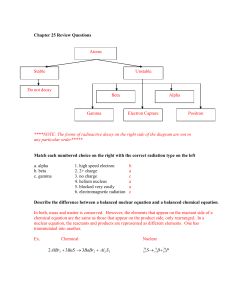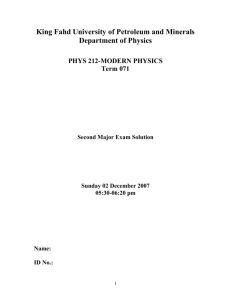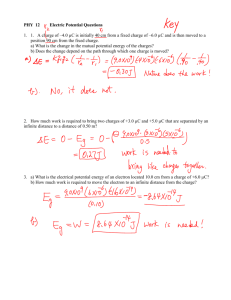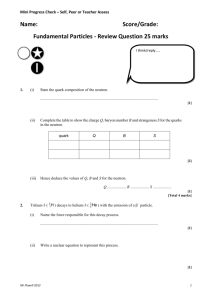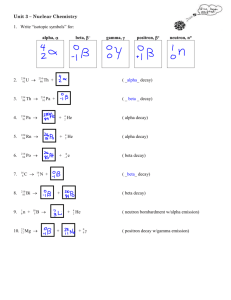File - Year 11 Revision
advertisement
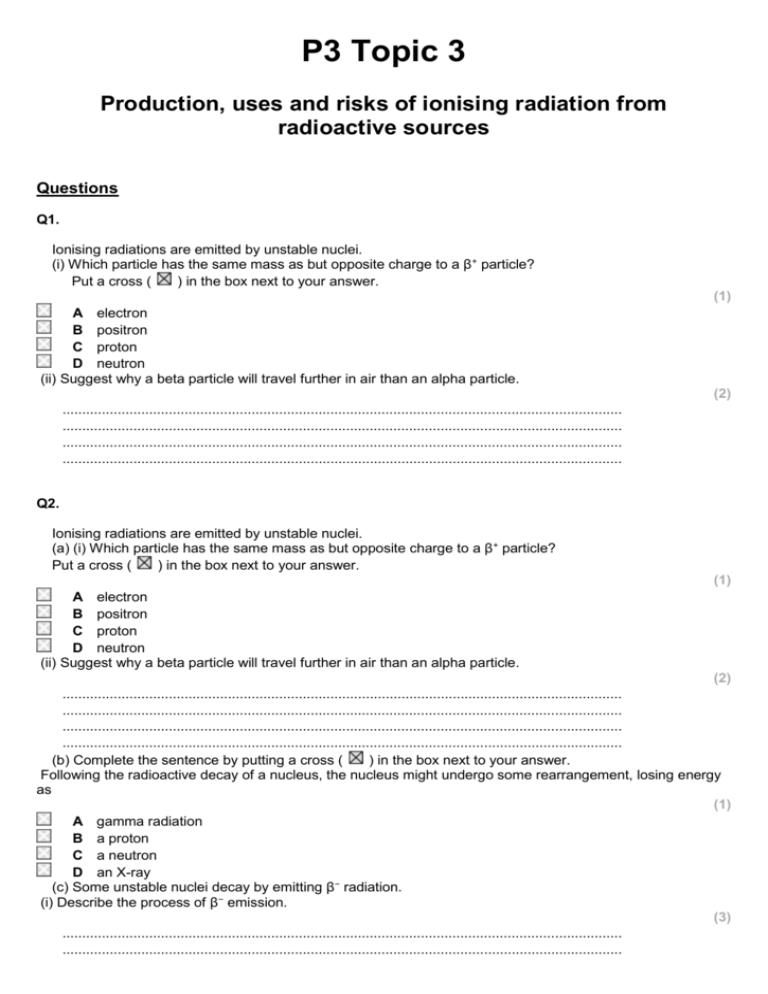
P3 Topic 3 Production, uses and risks of ionising radiation from radioactive sources Questions Q1. Ionising radiations are emitted by unstable nuclei. (i) Which particle has the same mass as but opposite charge to a β+ particle? Put a cross ( ) in the box next to your answer. (1) A electron B positron C proton D neutron (ii) Suggest why a beta particle will travel further in air than an alpha particle. (2) .............................................................................................................................................. .............................................................................................................................................. .............................................................................................................................................. .............................................................................................................................................. Q2. Ionising radiations are emitted by unstable nuclei. (a) (i) Which particle has the same mass as but opposite charge to a β+ particle? Put a cross ( ) in the box next to your answer. (1) A electron B positron C proton D neutron (ii) Suggest why a beta particle will travel further in air than an alpha particle. (2) .............................................................................................................................................. .............................................................................................................................................. .............................................................................................................................................. .............................................................................................................................................. (b) Complete the sentence by putting a cross ( ) in the box next to your answer. Following the radioactive decay of a nucleus, the nucleus might undergo some rearrangement, losing energy as (1) A gamma radiation B a proton C a neutron D an X-ray (c) Some unstable nuclei decay by emitting β− radiation. (i) Describe the process of β− emission. (3) .............................................................................................................................................. .............................................................................................................................................. .............................................................................................................................................. .............................................................................................................................................. .............................................................................................................................................. .............................................................................................................................................. (ii) Explain what happens to the mass number and the atomic number of a nucleus when β− emission occurs. (3) .............................................................................................................................................. .............................................................................................................................................. .............................................................................................................................................. .............................................................................................................................................. .............................................................................................................................................. .............................................................................................................................................. (Total for Question = 10 marks) Q3. Ionising radiations are emitted by unstable nuclei. Complete the sentence by putting a cross ( ) in the box next to your answer. Following the radioactive decay of a nucleus, the nucleus might undergo some rearrangement, losing energy as (1) A gamma radiation B a proton C a neutron D an X-ray Q4. Ionising radiations are emitted by unstable nuclei. Some unstable nuclei decay by emitting β− radiation. (i) Describe the process of β− emission. (3) .............................................................................................................................................. .............................................................................................................................................. .............................................................................................................................................. .............................................................................................................................................. .............................................................................................................................................. .............................................................................................................................................. (ii) Explain what happens to the mass number and the atomic number of a nucleus when β− emission occurs. (3) .............................................................................................................................................. .............................................................................................................................................. .............................................................................................................................................. .............................................................................................................................................. .............................................................................................................................................. .............................................................................................................................................. Mark Scheme Q1. Answer (i) (ii) A electron suggestion to include two of the ionisation is different (1) correct difference in ionisation (1) the masses are different (1) alpha is bigger than beta (1) alpha hits more (air) particles (1) alpha loses its energy in shorter distance (1) Acceptable answers Mark (1) alpha more ionising (than beta) scores 2 marks RA (heavier for bigger) RA RA IGNORE references to penetration (2) Q2. Answer (a)(i) (a) (ii) (b) A electron suggestion to include two of the ionisation is different (1) correct difference in ionisation (1) the masses are different (1) alpha is bigger than beta (1) alpha hits more (air) particles (1) alpha loses its energy in shorter distance (1) A gamma radiation Acceptable answers Mark (1) alpha more ionising (than beta) scores 2 marks RA (heavier for bigger) RA RA IGNORE references to penetration (2) (1) (c)(i) A description linking the following: neutron decays / changes / becomes (1) (neutron) into proton (1) (plus an) electron (1) quark changes (quark changes) from down to up / d to u e- (do not accept β- ) accept n and p for neutron and proton n > p + e- scores 3 marks IGNORE references to atomic and mass numbers; unstable nuclei; too (3) (c)(ii) An explanation linking three of the following: mass number doesn't change (1) (because) same number of nucleons / quarks (1) atomic number goes up by one (1) (because) there is an extra proton (1) many neutrons; gamma emitted emitted electron mass is negligible proton and neutron have same mass a neutron has (decayed in)to a proton (3) Q3. Answer Acceptable answers Mark A gamma radiation (1) Q4. Answer (i) A description linking the following: neutron decays / changes / becomes (1) (neutron) into proton (1) (plus an) electron (1) (ii) An explanation linking three of the following: mass number doesn't change (1) (because) same number of nucleons / quarks (1) atomic number goes up by one (1) (because) there is an extra proton (1) Acceptable answers quark changes (quark changes) from down to up / d to u e- (do not accept β- ) accept n and p for neutron and proton n > p + e- scores 3 marks IGNORE references to atomic and mass numbers; unstable nuclei; too many neutrons; gamma emitted emitted electron mass is negligible proton and neutron have same mass a neutron has (decayed in)to a proton Mark (3) (3) Examiner's Report Q1. (ii) Examiners were looking for responses to mention relative ionising ability or mass. Results Plus: Examiner Comments This scores both marks for saying that beta particles are less ionising than alpha particles. Q2. (a)(ii) Examiners were looking for responses to mention relative ionising ability or mass. Results Plus: Examiner Comments This scores both marks for saying that beta particles are less ionising than alpha particles. (c)(i) Responses in terms of a proton decaying into a neutron or quarks changing flavour were acceptable. Some candidates who tried both explanations contradicted themselves so lost some, if not all the marks. Results Plus: Examiner Comments Both strands are correct here and the beta minus particle identified as an electron. (c)(ii) Here candidates had to explain that the mass number did not change but the atomic number increased by 1. Results Plus: Examiner Comments An acceptable response for all 3 marks. Q3. No Examiner's Report available for this question Q4. (i) Responses in terms of a proton decaying into a neutron or quarks changing flavour were acceptable. Some candidates who tried both explanations contradicted themselves so lost some, if not all the marks. Results Plus: Examiner Comments Both strands are correct here and the beta minus particle identified as an electron. (ii) Here candidates had to explain that the mass number did not change but the atomic number increased by 1. Results Plus: Examiner Comments An acceptable response for all 3 marks.

